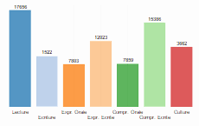| Grammaire |
Grammar Guide
Important: this module is still under development. Scores of articles will be added progressively. If you subscribed to the newsletter, you'll be notified by email.
Welcome to the Japanese grammar guide. Before starting using it, you might consider reading this short section to have a better understanding on how it works and how it can help you.
JLPT and Rank
The Grammar Guide contains many articles about Japanese structures and grammatical elements. These articles are ordered by JLPT levels (Japanese Language Proficiency Test, an international test for foreigners learning Japanese), and by rank (white belt, yellow belt, etc.)
The JLPT starts at level 5 (beginner) and goes down to level 1 (bilingual speaker). When you are taking JLPT Level 5 for instance, you should master the grammatical structures for this level. Also understand that no official grammar list exists. It means that during the test you might come across a few structures from level 4.
The rank refers to the belt color. When you are a member, you start white belt and win points by doing exercises. As you get more and more points, your belt color changes. So the rank in the Grammar Guide helps you see what structures you should learn depending on your current skills.
Verbal conventions
Many verbal structures display symbols such as vTe, vConj, vNeg, etc. If you already know Japanese well, you may quickly understand what they mean without further explanation. "v" stands for Verb and Te for instance means that it's the TE form of the verb that must be used in the structure. vConj means that it's the Conjunctive base of the verb that must be used, etc.
If you don't understand what the TE form or conjunctive base is, you should first learn the progressive lessons (lessons module). These lessons will explain much about the basics. There are also 4 lessons dedicated to verbs. Those 4 lessons explain well what verbal bases and forms are, and how to build them. Be sure to spend some time on them to get the most out of this Grammar Guide.
Here are a few symbols used in the Guide:
| Symbol | Meaning |
|---|---|
| vDic | dictionary base (also called neutral base) |
| vNeg | negative base |
| vConj | conjunctive base (also called connective base) |
| vCond | conditional base |
| vVol | volitional base |
| vTe | -te form |
| vTa | -ta form |
| vTara | -tara form |
| vTari | -tari form |
Example conventions
Many examples are given to clarify the explanation. In the Grammar Guide, most of the examples look like this:
| 私の前に犬がいません。 |
| 私の前に犬がいない。 |
| わたしのまえにいぬがいません。 |
| There isn't any dog in front of me. |
So why are there 3 different Japanese sentences??
- The two first rows show the Kanji version, one being in the polite form and the other in the neutral form. The neutral form is used among friends and family. The polite form often uses the -MASU suffix on verbs.
- The third row is the Kana version for the first row, in other words it helps you read the first row if you can't read Kanji easily.
- The last row is the translation in English naturally.
Where is the Roman version to read Japanese easily? The choice was made not to include the Romaji version. When Kanji can take a very long time to master, Kana can be learned quickly and is the minimum to do when you are learning Japanese. It's also a good way to practice your reading with real Japanese material.



















